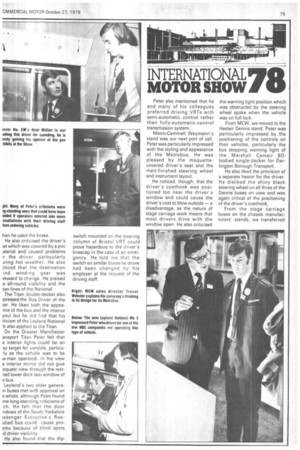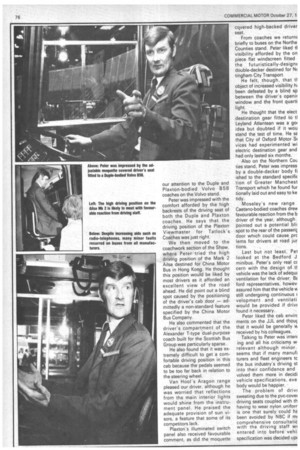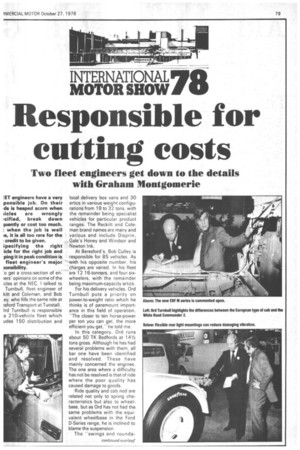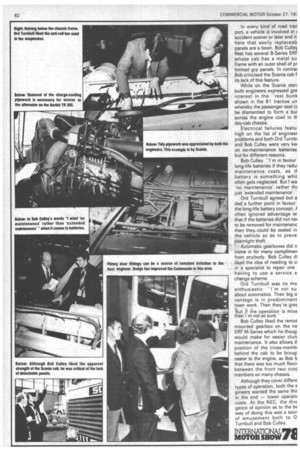INTERNATIONAL PM
Page 77

Page 78

Page 81

Page 82

Page 83

Page 84

If you've noticed an error in this article please click here to report it so we can fix it.
MOTOR SHOW
Peter also mentioned that he and many of his colleagues preferred driving VRTs with semi-automatic control rather than fully-automatic-control transmission system.
Metro-Cammell Weymann's stand was our next port of call. Peter was particularly impressed with the styling and appearance of the Metrobus. He was pleased by the moquettecovered driver's seat and the matt-finished steering wheel and instrument layout.
He noticed, though, that the driver's coathook was positioned too near the driver's window and could cause the driver's coat to blow outside — a disadvantage-, as the nature of stage carriage work means that most drivers drive with the window open. He also criticised the warning light position which was obstructed by the steering wheel spoke when the vehicle was on full lock.
From MCW, we moved to the Hestair Dennis stand. Peter was particularly impressed by the positioning of the controls on their vehicles, particularly the bus stopping warning light of the Marshall Camair SObodied single-decker for Darlington Borough Transport.
He also liked the provision of a separate heater for the driver. He disliked the shiny black steering wheel on all three of the Dennis buses on view and was again critical of the positioning of the driver's coathook,.
From the stage carriage buses on the chassis manufacturers' stands, we transferred our attention to the Duple and Plaxton-bodied Volvo B58 coaches on the Volvo stand.
Peter was impressed with the comfort afforded by the high backrests of the driving seat of both the Duple and Plaxton coaches. He says that the driving position of the Plaxton Viewmaster for Tatlock's Coaches was just right.
We then moved to the coachwork section of the Show, where Peter tried the high driving position of the Mark 2 AiIse destined for China Motor Bus in Hong Kong. He thought this position would be liked by most drivers as it afforded an excellent view of the road ahead. He did point out a blind spot caused by the positioning of the driver's cab door — admittedly a non-standard feature specified by the China Motor Bus Company.
He also commented that the driver's compartment of the Alexander T-type dual-purpose coach built for the Scottish Bus Group was particularly sparse.
He also found that it was extremely difficult to get a com fortable driving position in this cab because the pedals seemed to be too far back in relation to the steering wheel.
Van Hool's Aragon range pleased our driver, although he was worried that reflections from the main interior lights would shine from the instru ment panel. He praised the adequate provision of sun visors, a feature that some of its competitors lack.
Plaxton's illuminated switch panel also received favourable comment, as did the moquette covered high-backed driver seat.
From coaches we return( briefly to buses on the Northe Counties stand. Peter liked ti visibility afforded by the on piece flat windscreen fitted the futuristically-designE double-decker destined for Nc tingham City Transport.
He felt, though, that 9 object of increased visibility hi been defeated by a blind sp between the driver's openir window and the front quart( light. .` • .
He thought that the elect destination gear fitted to tl Leyland Atlantean was a goi idea but doubted if it wou stand the test of time. He sa that City of Oxford Motor So vices had experimented wi electric destination gear and had only lasted six months.
Also on the Northern Cou ties stand, Peter was impress. by a double-decker body fi ished to the standard specific tion of Greater Manchest Transport which he found fur tionally laid out and easy to ke tidy.
Moseley's new range Caetano-bodied coaches drev+ favourable reaction from the b driver of the year, although pointed out a potential bli spot to the rear of the passen( door which could cause prc lems for drivers at road jur tions.
Last but not least, Pet looked at the Bedford J minibus. Peter's only real cc cern with the design of 9 vehicle was the lack of adequi ventilation for the driver. BE ford representatives, howev. assured him that the vehicle +A still undergoing continuous ( velopment and ventilati would be provided if driw found it necessary.
Peter liked the cab envirc merits on the JJL and thou( that it would be generally +A received by his colleagues.
Talking to Peter was inter( ing and all his criticisms w.
relevant although minor, seems that if many manufi turers and fleet engineers tc the bus industry's driving st into their confidence and volved them more in decidi vehicle specifications, eve body would be happier. •
The problem of drivE sweating due to the pvc-cover driving seats coupled with th having to wear nylon uniforr is one that surely could he been avoided by NBC if mr comprehensive consultatic with the driving staff Wf entered into before vehi. specification was decided up( -o get a cross-section of ener-s' opinions on some of the ides at the NEC, I talked to Turnbull, fleet engineer of kitt and Coleman, and Bob ey, who fills the same role at .isford Transport at Tunstall. )rd Turnbull is responsible a 210-vehicle fleet which udes 150 distribution and
local delivery box vans and 30 artics in various weight configurations from 18 to 32 tons, with the remainder being specialist vehicles for particular product ranges. The Reckitt and Coleman brand names are many and various and include Disprin, Gale's Honey and Windsor and Newton Ink.
At Beresford's, Bob Culley is responsible for 85 vehicles. As with his opposite number, his charges are varied. In his fleet are 12 16-tonners, and four sixwheelers, with the remainder being maximum-capacity artics.
For his delivery vehicles, Ord Turnbull puts a priority on power-to-weight ratio which he thinks is of paramount importance in this field of operation. "The closer to ten horse-power per ton you can get, the more efficient you get," he told me.
In this category, Ord runs about 50 TK Bedfords at 141/2 tons gross. Although he has had several problems with them, all bar one have been identified and resolved. These have mainly concerned the engines. The one area where a difficulty has not be resolved is that of ride where the poor quality has caused damage to goods.
Ride quality and cab nod are related not only to spring characteristics but also to wheelbase, but as Ord has not had the same problems with the equivalent wheelbase in the Ford D-Series range, he is inclined to blame the suspension.
The "swings and rounda bouts" syndrome is well illustrated here, as Ord prefers the slipper-ended springs of the TK to the fixed type on the Ford because there are fewer expensive breakages.
Still with the TK, Ord Turnbull feels that the cab is very dated, and while it is possible to do basic maintenance via the hinged side panels, anything more comprehensive means a complete cab removal.
The power output of the TK was considered up to the job requirements of multi-drop delivery. Once a long-haul vehicle gets up speed, it is a relatively easy matter to keep it up with a comparatively low-powered engine. But a distribution vehicle with its daily round of stops and starts requires a higher powerto-weight ratio, thinks Mr Turnbull, and he criticised several manufacturers on this count.
Should the chassis be constructed from bolts or rivets? The argument has an equal number of adherents on each side. This was well illustrated by my two engineers. Bob Culley leans towards bolted frames while Ord Turnbull's fleet consists mostly of vehicles with riveted chassis.
Although Bob Culley admitted to having occasional problems with the bogies of his six-wheelers, "at least you can tighten up the bolts''. If the loosening has caused the holes to elongate, it is possible to plate the chassis and enlarge the holes before fitting new bolts,
Ord Turnbull's vehicles, -which have a four weekly FTA inspection, have by contrast never had any problems with their riveted frames. "About one per cent of the reports mention loose rivets,he said.
Breaking systems and their sometimes confused layouts was one area where Messrs Turnbull and Culley were in complete agreement. Both liked — in principle at least — the use of colour-coded pipevvork but Bob Culley raised the point that this system worked well until the workshop ran out of that particular colour.
"Do we hold the vehicle until the right colour coding is available or do we get it back on the road as soon as possible?" he asked.
Ord Turnbull highlighted one problem very succinctly when he said that although it was next to impossible to connect colourcoded piping incorrectly, -some clowns will try it!"
Synchromesh versus constant-mesh has been one of the interesting issues at this year's Show, Ord Turnbull and Bob Culley have strong views on the subject — although again their views differ, reflecting the different types of operation of their respective fleets.
At Beresford, Bob Culley prefers constant-mesh. He has experienced the old problem of failure of the synchronising cones on small and large synchro boxes.
In the distribution field the problem is more acute. Ord Turnbull has found that many drivers cannot drive anything but synchromesh and that it is essential to use this type of box if the driver is to get the best from the vehicle.
The subject of tyre sizes and their effect on platform height was raised by Mr Turnbull. As far as he is concerned, low profile tyres can reduce the loading height by up to four inches, which is a useful bonus for the driver who unloads cases all day. Ord Turnbull does not specify low-profile tyres because such an option adds around two months to the delivery date.
Both fleet engineers showed a great deal of interest in the White Road Commander 2 — not because it was particularly applicable to either of their operations, but because of certain design features.
The impressive engine access permitted by the tilt cab was praised by both. "One of the best I've seen," said Ord Turnbull. Tilt cabs — especially ones which can be tilted quickly — are of particular interest to Bob Culley.
"Apart from the obviously better access, the fitters can see a lot more without having to remove things — so they can spot more faults before anything. actually goes wrong."
The extensive use of aluminium on the White and, to a lesser extent, on the Volvo F7 particularly interested Bob, who has worked in the USA for a couple of years. He liked the use of aluminium to save weight but admitted the fatigue life was an unknown quantity to him.
He was not enthusiastic about the aluminium fuel tanks used on these chassis. "just at the right height for a fork-lift to hit."
Ord Turnbull is a tremendous advocate of tidying up the airflow around the vehicle to minimise aerodynamic drag. He was interested in the air-dam mounted below the bumper on the MAN 280, but less than enthusiastic about the untidy seams of the J-Series Saviem cab. "That sort of ridiculous edge costs fuel,he said.
In every kind of road tran port, a vehicle is involved in E accident sooner or later and it here that easily replaceab panels are a boon. Bob Culleiy fleet has several B-Series ERF whose cab has a metal su frame with an outer shell of pr formed grp panels. In contra: Bob criticised the Scania cab f its lack of this feature.
While on the Scania stan both engineers expressed gre interest in the –rest bunk shown in the 81 tractive un whereby the passenger seat cE be dismantled to form a but across the engine cowl in th day-cab chassis.
Electrical failures featu high on the list of engineer problems and both Ord Turnbi and Bob Culley were very ket on no-maintenance batteries, but for different reasons.
Bob Culley: "I'm in favour long-life batteries if they redui maintenance costs, as th battery is something whir often gets neglected. But I wa 'no maintenance' rather thE just 'extended maintenance':
Ord Turnbull agreed but a ded a further point in favour the long-life battery concept. X often ignored advantage wi that if the batteries did not nef to be removed for maintenanc then they. could be sealed in the vehicle so as to preve overnight theft.
Automatic gearboxes did n come in for many complimen from anybody. Bob Culley di liked the idea of needing to ci in a specialist to repair one having to use a service e change scheme.
Ord Turnbull was no mo enthusiastic. "I'm not su about automatics. Their big a vantage is in predominant town work. Then they're greE But 11 the ioperation is Mixe then I'm not so sure."
Bob Culley liked the rernot mounted gearbox on the ne ERF M-Series which he thoug would make for easier clutc maintenance. It also allows th position of the cross-membi behind the cab to be broug nearer to the engine, as Bob fr that there was too much flexir between the front two cros members on many chassis.
Although they cover differe types of operation, both the e gineers wanted the same thii in the end — lower operatii costs. At the NEC, the divE gence of opinion as to the bE way of doing this was a sour of amusement both to 0 Turnbull and Bob Culley.
































































































































































